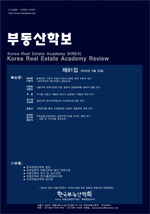- 영문명
- A Study on the Elderly Population and Welfare Housing by Region
- 발행기관
- 한국부동산학회
- 저자명
- 이호현(Ho Hyun Lee)
- 간행물 정보
- 『부동산학보』第96輯, 91~104쪽, 전체 14쪽
- 주제분류
- 경제경영 > 경제학
- 파일형태
- 발행일자
- 2025.06.30
4,480원
구매일시로부터 72시간 이내에 다운로드 가능합니다.
이 학술논문 정보는 (주)교보문고와 각 발행기관 사이에 저작물 이용 계약이 체결된 것으로, 교보문고를 통해 제공되고 있습니다.

국문 초록
현재 대한민국은 전 세계적으로 가장 빠른 속도로 저출산·고령화 시대에 진입하여 새로운 사회적 도전에 계속해서 직면하고 있다. 올해 2025년에는 노인 인구가 전체 인구의 약 20% 이상을 차지하면서 초고령 사회에 진입하였다. 이는 노인복지주택 정책과 관련된 중요성을 더욱 부각시킬 것이며, 노인들의 복지주택에 대한 필요성이 지속적으로 증가할 것임을 암시하는 것이다. 이렇듯 급격한 초고령 사회 진입으로 인해 노인의 인구는 꾸준히 증가하고 있어 이에 따른 노인들의 주거 문제는 사회적 관심사로 떠오르고 있는 추세이다. 이에 본 연구에서는 지역별 노인의 인구 비율과 이동 현황, 노인복지주택의 실태를 분석하는 것에 목적을 두었다. 분석 결과, 노인복지주택은 대도시에 집중적으로 분포하고 있으나 지방 소규모 도시에서는 공급이 상대적으로 부족한 상황이었다. 또한, 전국 단위에서 대도시 중심일수록 젊은 층의 비율이 높아 고령화 비율이 낮게 나타나는 반면, 지방 도시들은 고령화 비율이 상대적으로 높은 것을 확인하였다. 전반적으로 노인복지주택은 초고령 사회에서 필수적인 복지 인프라로 꼽히기에 지역별 특성과 노인의 요구에 맞춘 발전이 필요하다. 즉, 노인복지주택은 노인들의 다양한 요구와 지역적 특성을 반영한 맞춤형 지원을 통해 지속가능한 복지 모델로 발전해야 하며, 이를 위해 다양한 사회·경제적 지원이 종합적으로 이루어지는 것이 중요할 것이라고 사료된다.
영문 초록
1. CONTENTS
(1) RESEARCH OBJECTIVES
The purpose of this study is to analyze the proportion of the population and movement of the elderly by region, and the actual condition of welfare housing for the elderly. To this end, we will comprehensively review the policy trends of welfare housing for the elderly, spatial distribution according to the elderly welfare housing and aging index by region. In particular, it is meaningful to establish basic data in examining the current status through spatial information system (GIS) analysis and seeking future improvement possibilities of welfare housing for the elderly.
(2) RESEARCH METHOD
As necessary data for conducting this study, report data provided by the Ministry of Health and Welfare and the National Statistical Office, academic and degree papers, and various websites were referred to. In particular, an analysis of the actual condition was performed based on the data on future population estimation provided by the National Statistical Portal (KOSIS).
(3) RESEARCH FINDINGS
Efforts are being made to develop welfare housing for the elderly in various ways to improve housing stability and quality of life, and various efforts are being made to improve housing stability and quality of life for the elderly. In particular, strengthening the legal and institutional foundation, strengthening the linkage of welfare services in residential areas, creating a community-based residential environment, designing various housing types, expanding private participation, and expanding financial support are all important policy trends that enable the elderly to live safely in welfare housing. These efforts are considered to be an important basis for ensuring housing stability for the elderly in the future and improving their quality of life.
2. RESULTS
Currently, Korea continues to face new social challenges as it enters the era of low birth rate and aging at the fastest pace in the world. This year in 2025, the elderly population has entered a super-aged society with more than 20% of the total population. This will further highlight the importance related to the elderly welfare housing policy, and implies that the elderly's need for welfare housing will continue to increase. Due to the rapid entry into a super-aged society, the population of the elderly is steadily increasing, and accordingly, the housing problem of the elderly is emerging as a social concern. Therefore, the purpose of this study was to analyze the proportion of the population and movement status of the elderly by region, and the actual condition of elderly welfare housing. As a result of the analysis, welfare housing for the elderly is distributed intensively in large cities, but supply is relatively insufficient in small local cities. In addition, it was confirmed that the proportion of young people is higher and the aging rate is lower in the center of large cities across the country, while local cities have a relatively high aging rate. Overall, welfare housing for the elderly is considered an essential welfare infrastructure in a super-aged society, so development tailored to the characteristics of each region and the needs of the elderly is necessary. In other words, welfare housing for the elderly should develop into a sustainable welfare model through customized support that reflects the diverse needs and regional characteristics of the elderly, and for this purpose, it will be important to provide comprehensive social and economic support.
목차
Ⅰ. 서론
Ⅱ. 이론적 검토
Ⅲ. 노인 인구와 복지주택의 실태 분석
Ⅳ. 결론
참고문헌
키워드
해당간행물 수록 논문
참고문헌
관련논문
경제경영 > 경제학분야 NEW
- 농가의 영농 중단 의사에 영향을 미치는 요인 분석: 희귀사건 로짓모형 적용
- Examining the Impact of Nitrogen Fertilizer Price Surge and Risk on Import Demand Allocation
- Intergenerational Transmission of Environmental Values: How Parental Attitudes Influence Willingness to Pay for Forest Conservation
최근 이용한 논문
교보eBook 첫 방문을 환영 합니다!

신규가입 혜택 지급이 완료 되었습니다.
바로 사용 가능한 교보e캐시 1,000원 (유효기간 7일)
지금 바로 교보eBook의 다양한 콘텐츠를 이용해 보세요!



